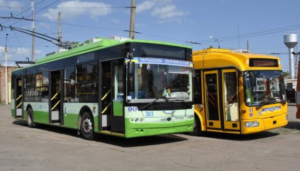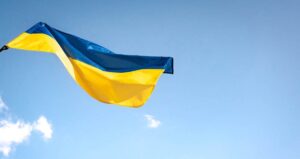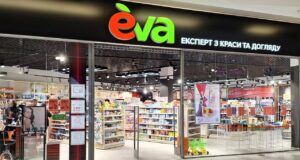
The European Bank for Reconstruction and Development (EBRD) is providing a €16 million loan to Cherkasy to finance the purchase of modern trolleybuses and the modernization of the relevant infrastructure, according to a statement on the EBRD website.
The loan, fully guaranteed by the city, will be co-financed by an investment grant of up to EUR4 million from the EBRD’s Shareholders’ Special Fund and will have partial first-loss risk coverage under the EU Investment Program for Municipal Infrastructure and Industrial Resilience (UIF MIIR).
The EBRD notes that the financing will enable Cherkasyelektrotrans to expand its fleet with new low-floor trolleybuses, modernize its depot and other infrastructure, and expand and redistribute three trolleybus routes.
According to information on the Cherkasy City Council website, the project involves attracting EBRD loan funds for the purchase of trolleybuses with a range of up to 20 km.
“Cherkasy has been preparing to implement this project for almost 10 years. Due to previous debt obligations, the city was unable to obtain a loan for a long time, but after a positive conclusion from the Ministry of Finance, active work on the final decisions was carried out over two years. Currently, all key approvals have been obtained,” said Cherkasy Mayor Anatoliy Bondarenko.
Thanks to the project, Cherkasy will be able to renew up to 90% of the rolling stock of the Cherkasyelektrotrans municipal enterprise.
As reported, the rolling stock of Cherkasyelektrotrans currently includes 12-meter Bogdan trolleybuses manufactured in 2015, Belarusian BKM trolleybuses manufactured in 2012, LAZ trolleybuses manufactured in 2006 and 2008, one articulated Aviant-Kyiv trolleybus manufactured in 1997, as well as ZiU trolleybuses manufactured in the 1980s and 1990s.
Last year, local authorities announced that they wanted to purchase approximately 45 trolleybuses with EBRD loan funds. Currently, the plan is to purchase up to 44 vehicles.

€16 million, with EU support, will support procurement of modern trolleybuses and infrastructure improvements
The European Bank for Reconstruction and Development (EBRD) is lending €16 million to the City of Cherkasy in Ukraine to finance the purchase of modern trolleybuses and the upgrade of related infrastructure for the city. The investment will strengthen sustainable urban mobility and ensure uninterrupted public transport services amid the wartime challenges facing Ukraine.
The loan, fully guaranteed by the City, will be co-financed by an investment grant of up to €4 million from the EBRD Shareholder Special Fund and will benefit from partial first loss risk cover under the European Union’s Ukraine Investment Framework Municipal Infrastructure and Industrial Resilience Programme (UIF MIIR). This promotes green transition and resilience in Ukraine’s economy by supporting sustainable investments in green city infrastructure, greening logistics chains, energy efficiency and green technology transfers.
The financing will enable Cherkasyelektrotrans, the municipal public transport operator in Cherkasy, to expand its fleet with new low-floor trolleybuses, modernise depots and other infrastructure, and extend and realign three trolleybus routes.
The project forms part of the EBRD’s Resilience and Livelihoods Framework, aimed at safeguarding essential municipal services during wartime. It will improve mobility for residents, including internally displaced people, and significantly reduce polluting emissions, contributing to better air quality. Aligned with the Paris Agreement’s mitigation and adaptation goals, the project is classified as 100 per cent green finance.
It also promotes inclusion by increasing accessibility for passengers with limited mobility and supporting gender equality through a partnership with UN Women’s She Drives programme, which will train and certify women and youth as trolleybus drivers.
By investing in Cherkasy’s public transport system, the EBRD is helping to maintain vital services, strengthen resilience and advance Ukraine’s green transition during a time of unprecedented challenge.
The EBRD has substantially increased its investments in Ukraine since Russia began its full-scale war there in 2022, deploying more than €8.5 billion to support energy security, vital infrastructure, food security, trade and the private sector.

The European Bank for Reconstruction and Development (EBRD) has provided Credit Agricole Bank (Kyiv) with a new guarantee that will enable the financial institution to issue loans to Ukrainian enterprises in the amount of EUR 150 million and cover up to 80% of the risk on them.
“We have a long-standing partnership with the EBRD and share a common vision of investing in resilience and sustainable development. Together, we are helping businesses recover, strengthen, and reduce their dependence on external risks, which is fully in line with our AIR strategy: Aim is to Invest in Recovery,” said Carlos de Cordoba, Chairman of the Board of Credit Agricole Bank, in a press release on Tuesday.
Under the terms of the program, Credit Agricole Bank will provide EUR 150 million to companies operating in critical sectors, as well as SMEs and mid-cap companies investing in energy production and storage, energy efficiency, and modernization.
As noted on the EBRD website, the project is divided into three components: the Resilience and Livelihoods Program, the Energy Security Support Facility, and the EU4Business–EBRD credit line with investment incentives.
The largest share of the portfolio coverage – up to EUR 80 million – is intended to finance working capital and private business investments in key sectors. EUR 40 million is earmarked for power generation, energy storage, and energy efficiency, and EUR 30 million for the modernization of MSMEs in line with EU standards, of which at least 70% must support green projects. This block provides for technical assistance and grant incentives after the completion of investments.
Eligible enterprises will also be able to receive technical assistance and investment incentives funded by the EU under the EU4Business initiative. Additional grants are provided for businesses and households that have suffered destruction, loss of assets, forced displacement, as well as for companies that promote the reintegration of veterans, persons with disabilities, and IDPs.
It is noted that this is already the third agreement on portfolio risk sharing between the EBRD and Credit Agricole Bank since the start of the full-scale invasion by the Russian Federation.
The EBRD has previously allocated EUR 75.4 million in EU grants to Ukrainian MSMEs under the EU4Business-EBRD line, of which EUR 2.25 million was allocated to projects involving Credit Agricole Bank.
According to the EBRD, since the start of the full-scale invasion, the bank has provided Ukrainian borrowers with approximately EUR 3.29 billion through 40 similar agreements with 12 partners. The loan programs are supported by partial coverage of first-loss risk, which is financed by France and the EU under the Investment Facility for Ukraine (UIF).
Credit Agricole Bank was founded in 1993, and its sole shareholder is Credit Agricole S.A. (France). According to the NBU, as of October 1, 2025, the bank ranked 11th (UAH 116.26 billion) among 60 banks in Ukraine in terms of assets.

The Kryvyi Rih Mining and Metallurgical Plant PJSC ArcelorMittal Kryvyi Rih (AMKR, Dnipropetrovsk region) intends to attract a loan of up to $200 million from the European Bank for Reconstruction and Development (EBRD).
According to the company, on November 26, 2025, the supervisory board of AMKR approved a significant transaction—securing a loan from the EBRD.
The market value of the property or services that are the subject of the transaction is determined in accordance with the law: no more than $200 million (UAH 8,480,300 thousand at the NBU exchange rate as of November 26, 2025). The value of the issuer’s assets, according to the latest annual financial statements, is UAH 51,725,655 thousand. The ratio of the market value of the property or services that are the subject of the transaction to the value of the issuer’s assets, according to the latest annual financial statements (in percent) is 16.3947658082%.
ArcelorMittal Kryvyi Rih is the largest producer of rolled steel in Ukraine. It specializes in the production of long products, in particular, rebar and wire rod. The company has a full production cycle, with production capacities designed for an annual output of over 6 million tons of steel, more than 5 million tons of rolled products, and over 5.5 million tons of pig iron.
ArcelorMittal owns Ukraine’s largest mining and metallurgical complex, ArcelorMittal Kryvyi Rih, and a number of small companies, including ArcelorMittal Beryslav.

The European Bank for Reconstruction and Development (EBRD) is providing a risk-sharing guarantee without financing in the amount of UAH150 million (EUR3.1 million) to cover half of the loan issued by Ukrsibbank to retailer EVA for the development of its logistics hubs, the company’s press service reported.
“This agreement is an important milestone for EVA and our first experience of cooperation with the European Bank for Reconstruction and Development. We underwent a thorough analysis by the EBRD, which confirmed EVA’s financial stability, the compliance of our activities with the criteria of Ukrsibbank and the EBRD for borrowers, and the recognition of our company as a reliable partner capable of developing its business even in wartime,” said Lilia Volenko, CFO of Rush LLC (EVA and eva.ua network), in a press release.
It is noted that this agreement was the first time the bank used the EBRD’s risk-sharing program (individual investment loan guarantee) to provide an investment loan to a corporate client. Previously, risk sharing rules allowed the bank to share risks only for working capital financing transactions.
According to Volenko, this agreement is a signal to the market about the possibility of attracting long-term financing with the support of international institutions in wartime.
Rush LLC, which manages the EVA chain, was founded in 2002. The chain has over 1,100 stores.
According to YouControl, the owner of Rush LLC is listed as Cyprus-based Incetera Holdings Limited (100%), with Ruslan Shostak and Valery Kiptik as the ultimate beneficiaries.
At the end of the third quarter of 2025, Rush’s net income increased by 18.6% compared to the same period last year, reaching UAH 22.9 billion. Net profit decreased by 14.7% to UAH 1.7 billion.

Serhiy Ustenko, owner of the Carpathian Mineral Waters group, signed a €11 million loan agreement with the European Bank for Reconstruction and Development (EBRD) during the ReBuild Ukraine 2025 conference in Warsaw, according to a Facebook post by the National Association of Extractive Industries of Ukraine.
“The investment will be used to build a modern, energy-efficient beverage production plant in Lviv region, which is an important contribution to Ukraine’s food security and the development of sustainable production,” the statement said.
It is expected that, as part of the implementation of an inclusive employment model, the company will create at least 50% of jobs for veterans and people with disabilities.
“The financing will allow us to expand our production capacity and make our business even more environmentally friendly and socially responsible. Thank you for investing in the development of KMW and food security in Ukraine,” Ustenko said, thanking the EU and the EBRD for their trust and support.
The association recalled that Karpatski Mineralni Vody purchased a special water permit for a new plant near Zolochiv. The company paid UAH 26 million for the plot at auction.
According to the Karpatski Mineralni Vody website, the company began operating in the mineral water market in 1996 with the first bottling of Karpatskaya Dzherelna natural mineral table water. In June 2002, it was reorganized into a plant for the production of mineral water and non-alcoholic beverages, Karpatski Mineralni Vody. At the same time, the company began producing sweet carbonated drinks under the Fruktova Dzherelna and Sokovinka brands, and in 2016, the Dragon energy drink.
CONSTRUCTION, EBRD, KMW, PLANT